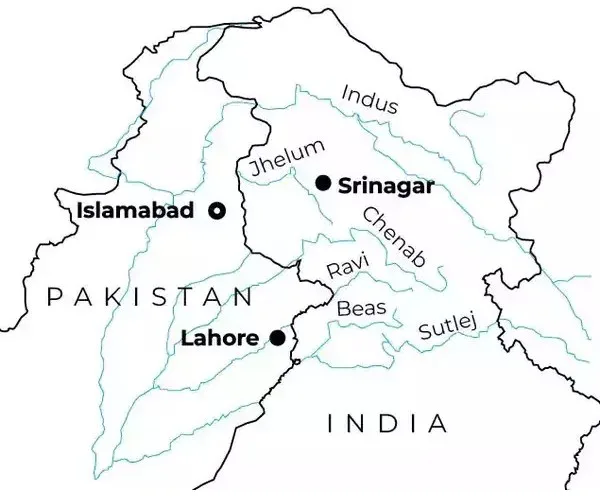Syllabus: GS1/Geography; GS2/India and Its Neighbourhood
Context
- Recently, the Neutral Expert appointed by the World Bank declared competent to decide on the differences between India and Pakistan regarding the hydroelectric projects on the Indus and its tributaries.
About the Indus Water Treaty (IVT)
- It was signed in 1960, governs the water-sharing arrangements between India and Pakistan, and was brokered by the World Bank.

- It allocates the Eastern Rivers(Ravi, Beas, and Sutlej)to India, and the Western Rivers(Indus, Jhelum, and Chenab)to Pakistan.
- However, India is permitted limited use of western rivers for Non-Consumptive Use; Domestic Use; Agricultural Use, and Generation of hydro-electric power.
Key Features of IWT
- Allocation of Water Resources: The treaty allocates about 80% of the water from the Indus system to Pakistan, highlighting its dependence on these rivers.
- Permanent Indus Commission (PIC): Commissioners from both countries, to manage the treaty’s implementation and resolve disputes.
- Dispute Resolution: Detailed mechanism for resolving disagreements, involving bilateral negotiations, World Bank-facilitated mediation, and, if necessary, arbitration. For resolving disputes, the IWT outlines distinct mechanisms:
- ‘Questions’ are addressed by the Permanent Indus Commission (PIC);
- ‘Differences’ are addressed by a Neutral Expert, and;
- ‘Disputes’ are addressed by a Court of Arbitration.
- The World Bank’s role includes appointing individuals to these positions upon request from either country.
Key Disputes
- Pakistan has objected to several Indian hydroelectric projects, including the Kishanganga and Ratle plants etc, citing potential violations of the treaty’s provisions.
- Kishenganga river (Neelum) is a tributary of the Jhelum River.
- Ratle hydroelectric project is on Chenab River.
- Both India and Pakistan differed on whether the technical details of the hydel projects conformed with the treaty, given that the Jhelum and Chenab were part of the ‘western tributaries’.
Implications
- India has welcomed the Neutral Expert‘s decision as a significant step towards resolving the ongoing disputes by emphasizing all questions referred to the Neutral Expert fall within his competence under the treaty.
- It prevents the matters from being taken up by the Court of Arbitration (CoA), which Pakistan had sought.
| Indus River and Its Tributaries – Origin of Indus River: Bokhar Chu in the Tibetan region in the Kailash Mountain range near the Mansarovar Lake. 1. In Tibet, it is known as ‘Singi Khamban’ or the Lion’s Mouth. 2. It flows northwest and enters the Ladakh region of India at a place called Demchok. Tributaries of Indus River – Left Bank Tributaries: Zaskar River, Suru River, Soan River, Jhelum River, Chenab River, Ravi River, Beas River, Satluj River, and Panjnad River. – Right Bank Tributaries: Shyok River, Gilgit River, Hunza River, Swat River, Kunnar River, Kurram River, Gomal River, Tochi River, and Kabul River. Other Key Hydroelectric Projects on Western Rivers – On Indus: Nimmo-Bazgo (Leh); Stakna (Leh) – On Chenab: Baglihar Stage- I (Doda); Chenani on River Tawi (Udhampur, Tributary of Chenab); Dulhasti (Doda); – On Jhelum: Uri-I & II (Baramula); Ganderbal (Sri Nagar); Upper Sindh I &-II (Sindh Nallah tributary of Jhelum); |
Previous article
News In Short 21-1-2025
Next article
Status of the Smart Cities Mission